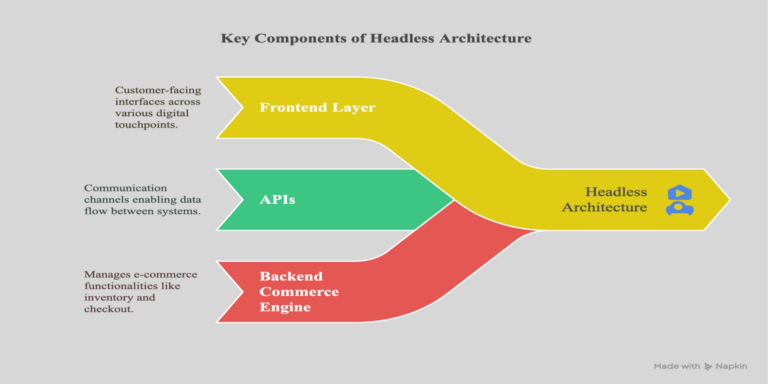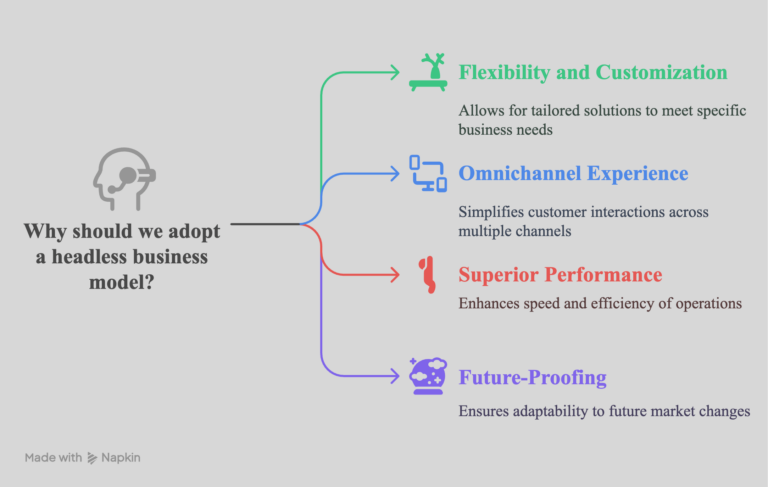Greetings! I'm Aneesh Sreedharan, CEO of 2Hats Logic Solutions. At 2Hats Logic Solutions, we are dedicated to providing technical expertise and resolving your concerns in the world of technology. Our blog page serves as a resource where we share insights and experiences, offering valuable perspectives on your queries.

Quick Summary
Headless commerce separates your customer-facing frontend from your backend commerce functionality, connecting them via APIs. This architecture provides ultimate flexibility, better performance, and true omnichannel capabilities, though it requires more technical resources than traditional all-in-one platforms. Leading brands like Nike, Koala, and Peloton have embraced headless commerce to create innovative customer experiences across multiple touchpoints.
Have you ever found yourself frustrated with rigid e-commerce platforms that limit your ability to create unique shopping experiences?
You’re not alone. Many businesses struggle with traditional commerce solutions that can’t keep pace with evolving customer expectations across multiple touchpoints.
This is exactly where headless commerce comes into play and possibly transforms your digital commerce strategy forever.
At 2Hats Logic, I’ve helped numerous businesses transition to headless architecture, and we’ve seen firsthand how it unlocks unprecedented flexibility and innovation.
Let’s dive into what headless commerce means and why it might be the game-changer your business needs.
What is Headless Commerce?
Headless commerce is an e-commerce architecture where the frontend presentation layer (the “head”) is decoupled from the backend commerce functionality (the “body”).
This separation allows each layer to operate independently, creating unprecedented flexibility in how your brand engages with customers.
Think of traditional e-commerce as a complete package; the storefront and all backend systems are tightly integrated.
In contrast, headless commerce splits these components, communicating through APIs (Application Programming Interfaces).
Ready to explore how headless architecture could transform your commerce strategy?
The Key Components of Headless Architecture
Take a look at all the components are there in the headless architecture system.

- Frontend Layer (The Missing “Head”): Customer-facing interface consists of websites, mobile apps, kiosks, voice assistants, or any digital touchpoint.
- APIs (The Connector): The communication channels that allow data to flow between frontend and backend systems.
- Backend Commerce Engine: The system handles core e-commerce functionalities like inventory, pricing, promotions, and checkout.
Why Businesses Are Going Headless
When we implemented headless commerce for an athletic equipment retailer, they saw a 43% increase in mobile conversion rates within just three months.
The ability to create a lightning-fast, custom mobile experience while maintaining their robust backend systems made all the difference.
Here’s why businesses are increasingly adopting headless commerce:

1. Ultimate Flexibility and Customization
With headless commerce, you can create truly unique customer experiences without backend constraints. Want to implement an innovative AR product visualization?
With a traditional platform, you might wait months for a plugin (if one ever comes). With headless, your frontend developers can build it immediately.
2. Omnichannel Experience Made Simple
Modern customers interact with brands across multiple touchpoints. They are websites, mobile apps, social media, voice assistants, and even IoT devices.
Headless architecture allows you to deliver consistent experiences across all these channels while maintaining a single source of truth in the backend.
3. Superior Performance
By separating the frontend from the backend processes, headless commerce platforms often deliver faster page loads and smoother interactions.
This speed directly impacts conversion rates. Amazon famously found that each 100ms of latency costs them 1% in sales.
4. Future-Proofing Your Business
New customer touchpoints emerge constantly. Remember when mobile shopping seemed cutting-edge? Now we have voice commerce, social commerce, and IoT devices.
Headless architecture allows you to adapt to these new channels without rebuilding your entire commerce infrastructure.
Pro-Tip: When evaluating headless commerce solutions, focus first on API capabilities and documentation quality. The most elegant frontend won’t matter if your APIs can’t efficiently deliver the right data at the right time.
Real-World Headless Commerce Examples
Let’s look at some companies that have successfully implemented headless commerce:
Nike

Nike embraced headless commerce to create seamless experiences across their website, mobile app, and in-store digital touchpoints. Their approach allows them to rapidly deploy new features and personalized experiences without disrupting backend operations.
Koala

This Australian furniture company uses a headless architecture to power their innovative shopping experience. Their product pages feature interactive 3D models, AR capabilities, and personalized content. These are all maintained with lightning-fast load times.
Peloton

Peloton’s business model connects physical products, digital content, and community features. Their headless approach enables them to create unified customer experiences across bikes, treadmills, mobile apps, and web platforms—all connected to the same commerce backend.
How Headless Commerce Works: A Technical Overview
Now let’s break down how headless commerce actually works from a technical perspective.
The API Layer: The Heart of Headless Commerce
The API layer is what makes headless commerce possible. These APIs fall into several categories:
- Commerce APIs: Handle core e-commerce functions like cart management, checkout, payment processing, and order management.
- Content APIs: Deliver product information, marketing content, and media assets.
- Search APIs: Power product discovery, filtering, and search functionality.
- Customer APIs: Manage user accounts, preferences, and personalization data.
Frontends: The Visible Part of Headless Commerce
The beauty of headless commerce is that you can build multiple frontends using different technologies, all connecting to the same backend. Common approaches include:
- Custom-built frontends: Developed using modern frameworks like React, Vue.js, or Angular.
- Progressive Web Apps (PWAs): Combining the best of web and mobile app experiences.
- Native mobile apps: iOS and Android applications with native performance.
- Digital experiences beyond the web: Voice assistants, kiosks, IoT devices, etc.
Headless Commerce vs. Traditional Commerce: A Comparison
To better understand the differences, let’s compare headless and traditional commerce approaches:
| Feature | Traditional Commerce | Headless Commerce |
|---|---|---|
| Flexibility | Limited by platform templates and plugins | Unlimited frontend customization |
| Development Speed | Fast for standard features, slow for custom work | Slower initial setup, but faster ongoing innovation |
| Performance | Often slowed by unnecessary code and features | Optimized performance with lean, purpose-built frontends |
| Omnichannel Capabilities | Usually requires separate solutions for each channel | Single backend powers all customer touchpoints |
| Cost | Lower upfront cost, higher long-term limitations | Higher upfront investment, better long-term value |
Implementing Headless Commerce: Key Considerations
When we helped a home décor retailer transition to headless commerce, their biggest challenge wasn’t technical; it was organizational.
Shifting to a headless mindset required new workflows between their marketing, design, and development teams.
1. Choose the Right Commerce Platform
Not all headless commerce platforms are created equal. Key platforms to consider include:
- API-first platforms: CommerceTools, Elastic Path
- Headless options from traditional vendors: Shopify Plus (with Storefront API), BigCommerce (with Headless API)
- Composable commerce solutions: Fabric, Swell, Nacelle
2. Plan Your Frontend Strategy
Will you build a custom frontend from scratch? Use a frontend-as-a-service solution? Or adopt a framework specialized for headless commerce like Next.js or Gatsby?
Your choice depends on your:
- Available development resources
- Required level of customization
- Timeline for implementation
3. Consider Your Content Strategy
Most headless commerce implementations pair the commerce platform with a headless CMS (Content Management System) like Contentful, Sanity, or Prismic. This gives marketing teams the tools to manage content independently of the development team.
4. Focus on the Developer Experience
The success of headless commerce heavily depends on your development team’s ability to work efficiently with your chosen tools. Prioritize:
- Comprehensive API documentation
- Strong developer communities
- Quality SDKs and starter kits
- CI/CD workflows for frequent, reliable deployments
Pro-Tip: Create a “storefront API” layer that aggregates data from multiple backend services (commerce, CMS, search, etc.) to simplify frontend development. This pattern, sometimes called Backend-for-Frontend (BFF), can significantly improve developer productivity.
Common Challenges and How to Overcome Them
Challenge 1: Increased Complexity
Headless commerce introduces more moving parts than all-in-one solutions.
Solution: Start with a phased approach. At 2HatsLogic, we often recommend beginning with a specific customer journey (like mobile checkout) rather than rebuilding everything at once.
Challenge 2: Content Preview
In traditional platforms, what you see in the CMS is what customers will see. In headless architecture, this connection isn’t automatic.
Solution: Implement preview environments that pull content and commerce data together, allowing content teams to see exactly how their changes will appear.
Challenge 3: Initial Development Costs
Building custom frontends requires more upfront investment than using templates.
Solution: Focus initial development on high-impact customer journeys with clear ROI potential. The beauty of headless is that you can migrate incrementally.
Concerned about navigating these potential headless commerce challenges?
Is Headless Commerce Right for Your Business?
Headless commerce isn’t for everyone. Here’s a quick self-assessment:
You might benefit from headless commerce if:
- Your business operates across multiple channels or touchpoints
- You need unique customer experiences that differentiate your brand
- Your current platform struggles with performance or flexibility
- You have (or can access) frontend development resources
You might be better with traditional commerce if:
- You’re just starting and need something simple
- Your customer journey is straightforward and standard
- You have limited technical resources or budget
- Speed to market is your absolute top priority
The Future of Headless Commerce: What’s Next?
The headless commerce landscape continues to evolve rapidly. Here are the trends we’re watching closely at 2HatsLogic:
1. Composable Commerce
The next evolution beyond headless is fully composable commerce, selecting best-of-breed components for each commerce function (checkout, search, promotions, etc.) rather than using a single backend platform.
2. AI-Powered Personalization
With frontend flexibility, businesses can implement sophisticated AI-driven personalization that adapts in real-time to customer behavior.
3. No-Code Frontend Builders
Tools are emerging that allow marketers and designers to build and modify headless frontends without developer involvement, bringing some of the convenience of traditional platforms to headless architecture.
Conclusion
Grasping the true headless commerce meaning reveals a transformative architecture that fundamentally reimagines how digital shopping experiences are constructed and delivered.
By strategically decoupling frontend presentation layers from backend business logic through robust APIs, headless commerce empowers businesses to craft distinctive customer journeys.
Ready to explore how headless commerce could transform your business? At 2HatsLogic, we’ve helped companies across industries implement successful headless commerce strategies tailored to their specific goals and resources.
Get in touch with us to discuss your headless commerce journey, or request a free assessment of your current commerce architecture. Let’s build something exceptional together.
FAQ
What is headless commerce?
Headless commerce is an architecture that separates the frontend presentation layer from the backend commerce engine, connecting them through APIs.
What are the main benefits of headless commerce?
The key benefits include greater flexibility for frontend customization, improved performance with faster page loads, and omnichannel capabilities.
Is headless commerce right for every business?
No. Headless commerce is ideal for businesses needing custom experiences across multiple channels with access to technical resources. Smaller businesses with standard needs and limited technical capabilities may benefit more from traditional all-in-one platforms.
Table of contents
- What is Headless Commerce?
- Why Businesses Are Going Headless
- Real-World Headless Commerce Examples
- How Headless Commerce Works: A Technical Overview
- Headless Commerce vs. Traditional Commerce: A Comparison
- Implementing Headless Commerce: Key Considerations
- Common Challenges and How to Overcome Them
- Is Headless Commerce Right for Your Business?
- The Future of Headless Commerce: What's Next?
- Conclusion

Related Articles






